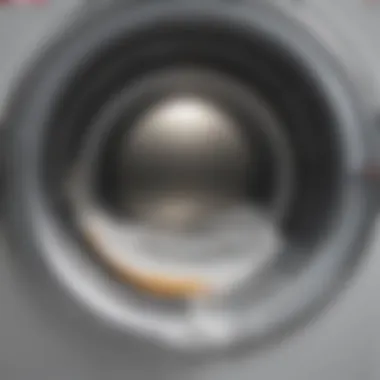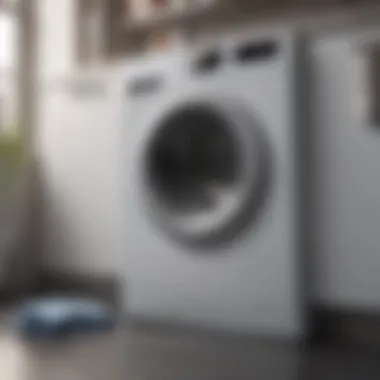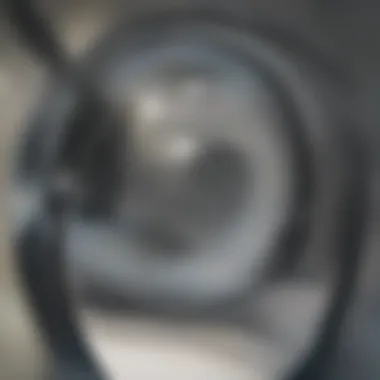Mastering the Art of Washing Machine Cleaning


Intro
Cleaning your washing machine is a crucial aspect of maintaining this essential appliance. Over time, residue, mold, and unpleasant odors can accumulate, impacting the machine's performance and your laundry's cleanliness. This guide aims to demystify the process of washing machine maintenance. By exploring effective cleaning methods and routines, you can enhance the lifespan of your appliance and improve its efficiency.
Many homeowners underestimate the importance of this task. Regular cleaning not only helps in preventing issues but also ensures that your clothes come out fresh and spotless. Additionally, a well-maintained machine can save on electricity and water usage, contributing to more sustainable living.
Here, we will cover various aspects of washing machine care. You will discover the necessity of routine maintenance, the cleaning methods suitable for your specific model, and the tools and materials that facilitate the process. Understanding these elements empowers you to take control of your washing practices effectively.
Foreword to Washing Machine Maintenance
Maintaining a washing machine is essential for optimal functionality and prolonging its lifespan. Many homeowners overlook this aspect, assuming that the machine operates efficiently without intervention. However, neglecting routine cleaning can result in a variety of problems, including unpleasant odors, inefficient washing performance, and even machine failures. This section explores the significance of washing machine maintenance, emphasizing both practical benefits and long-term considerations.
Understanding the Importance of Cleaning
Regular cleaning of a washing machine is not just about aesthetics; it directly impacts the appliance's efficiency. Over time, detergent residues, lint, and even minerals from water can accumulate inside the machine. This buildup can hinder the washing process, causing clothes to come out less clean.
Furthermore, mold and bacteria can thrive in the moist environment of a washing machine, leading to bad smells and potential health risks. By understanding these factors, users can appreciate that regular cleaning is crucial for hygiene and appliance performance. Incorporating cleaning into one's routine not only enhances the washing experience but also prevents costly repairs and replacements.
Frequency of Cleaning
Determining how often to clean a washing machine can vary. Factors such as frequency of use, the type of detergent used, and environmental conditions all play a role.
Ideally, users should clean their washing machines every month. This regularity helps to keep the machine running smoothly. It’s also advisable to perform deep cleaning at least twice a year. For front-loading machines, special attention should be given to seals and gaskets where moisture can get trapped, leading to mold.
For those who wash heavily soiled items, such as athletic gear or work uniforms, increasing the frequency of cleaning may be necessary. Frequent usage with harsh detergents or soft water is another cue to clean more often.
In summary, understanding the importance of cleaning along with establishing a consistent cleaning schedule are key aspects of washing machine maintenance that every homeowner should adopt.
Types of Washing Machines
Understanding the types of washing machines is essential for determining the appropriate cleaning methods and maintenance practices. Each type has its unique design and operating system, which influences how dirt and residue accumulate. Knowing these distinctions allows users to tailor their cleaning approach, addressing specific areas that may need more attention. This understanding can result in improved efficiency and longevity of the appliance.
Front-Loading Washing Machines
Front-loading washing machines are popular for their energy efficiency and superior cleaning capabilities. These machines use gravity to assist in washing clothes, which generally consumes less water compared to top-loaders. However, the design allows for moisture to become trapped in the door seal, potentially leading to mold and unpleasant odors over time.
Cleaning a front-loader involves regularly inspecting and wiping the rubber seals. Users should also run a cleaning cycle with a suitable cleaning agent, like vinegar, to remove any buildup in the drum or dispenser. Many front-loaders have specific maintenance guidelines provided by the manufacturer, which should be followed closely to prevent issues.
Top-Loading Washing Machines
Top-loading washing machines offer convenience and ease of access. With their design, users can easily add clothes during a wash cycle. Typically, they use more water than front-loaders, which can lead to residue buildup from the detergent. Because of this, it’s important to clean the drum and dispenser regularly.
Cleaning a top-loader mainly focuses on the interior drum as well as the detergent dispenser. Running a hot water cycle with a combination of baking soda and vinegar can help eliminate odors and dissolve buildup. It’s also wise to inspect for any visible residue inside or around the machine, which can be a key indicator of the need for a more thorough clean.
Washer-Dryer Combos
Washer-dryer combos represent a more compact solution for laundry needs. They combine washing and drying functions, making them ideal for smaller spaces. However, they can also accumulate residual lint and moisture, which could lead to mold and other issues.


Keeping a washer-dryer combo clean involves regular maintenance of both the washing and the drying components. Users should run a monthly self-cleaning cycle if available. The lint trap should be cleaned frequently to enhance performance during the drying cycle. This proactive approach can prevent potential malfunctions and keep the appliance running efficiently for a longer period.
"Regular maintenance and cleaning of your washing machine are crucial for optimal performance and longevity. Each type requires specific care to prevent issues from arising."
By familiarizing yourself with the different types of washing machines and their cleaning requirements, you can make informed decisions. This can lead to a cleaner, more efficient appliance that enhances your overall laundry experience.
Materials Required for Cleaning
Cleaning your washing machine effectively requires the right materials. Each element plays a vital role in ensuring that your machine maintains performance and longevity. Choosing better cleaning agents and tools not only improves cleanliness but also affects the overall health of the machine. Let's explore what to use and why it matters.
Choosing the Right Cleaning Agents
Vinegar
Vinegar is a simple yet effective cleaning agent. Its acidic properties help dissolve mineral deposits, which can accumulate over time. Vinegar is favored for being non-toxic and safe for both your machine and the environment. By using vinegar, you can keep your washing machine free from odors and bacteria. However, some machines may have specific guidelines against using vinegar, so check your model.
Baking Soda
Baking soda is another natural cleaner with many benefits. It acts as a gentle abrasive, helping to scrub away stains and residues in the drum. It is well-known for neutralizing odors, making it a popular choice for cleaning. Baking soda's uniqueness lies in its ability to lift stains without scratching surfaces. This comes in handy while maintaining the machine's finish. Nonetheless, excess use might lead to buildup if not rinsed properly.
Commercial Cleaning Products
Commercial cleaning products are specifically designed for washing machines and often contain powerful agents that target tough stains, odors, and buildup. They are convenient and use simple instructions. Many products claim to be fast-acting, allowing for quick maintenance. However, some may have harsh chemicals, posing risks to sensitive components or your health. Be sure to read the labels and choose wisely.
Essential Tools
Soft Cloths
Soft cloths are essential for any cleaning process. They are gentle yet effective against various surfaces. Using soft fabrics helps prevent scratches, allowing you to clean without damaging the finishes inside your washing machine. Soft cloths are typically made from microfiber, which is known for its durability and ability to trap dust and dirt. Still, they require regular washing to maintain their cleaning effectiveness.
Sponges
Sponges are versatile tools for cleaning. They can effectively absorb water and other cleaning agents, which makes them practical for scrubbing surfaces like drums or the exterior. Sponges come in different textures, some rougher for tougher stains and others softer for delicate areas. However, they can harbor bacteria if not rinsed and dried properly, so frequent replacement is advisable.
Old Toothbrushes
Old toothbrushes are surprisingly handy in cleaning a washing machine. Their bristles can reach tight spaces and remove stubborn grime that might not be easily accessible with larger tools. Toothbrushes are especially good for cleaning seals, gaskets, and small crevices where dirt can accumulate. While they may not be sustainable long-term, they offer a unique solution for detailed cleaning when appropriately utilized.
Step-by-Step Cleaning Process
Cleaning your washing machine is not merely about aesthetics; it is essential for optimal performance and longevity. A systematic cleaning approach ensures you're addressing all areas that may harbor dirt, grime, or even mildew. This step-by-step process delineates the crucial actions required to properly maintain your machine, preventing more significant issues down the line. Each task builds on the previous ones, ensuring a thorough clean that yields noticeable results.
Cleaning the Drum
Start by focusing on the drum, which holds your clothes during cycles. Over time, residue from detergents, fabric softeners, and lint can accumulate inside the drum. To clean it effectively:
- Select a Cleaning Agent: Use either a commercial washing machine cleaner or natural options like vinegar or baking soda.
- Run a Cleaning Cycle: If your machine has a cleaning cycle, select it. Otherwise, run a hot water cycle with the cleaning agent of your choice. This helps dissolve built-up deposits.
- Wipe Down Afterwards: Once the cycle is complete, use a soft cloth to wipe down the drum surface. This leaves it fresh and free of any lingering odors.


Wiping Down Seals and Gaskets
The seals and gaskets around your washing machine are often overlooked during cleaning. These areas can trap water and become breeding grounds for mold and mildew.
- Inspect the Seals: Begin with visual inspection. If you notice discoloration or mold, it requires immediate attention.
- Use Suitable Cleaning Agents: Apply a mixture of vinegar and water or a mild detergent to a soft cloth or sponge.
- Clean Thoroughly: Gently scrub the surfaces of the seals, ensuring every crease is attended to. A toothbrush can be helpful for tight spots.
Cleaning Detergent Dispenser
The detergent dispenser can accumulate detergent residue, which leads to clogs and compromised cleaning performance.
- Remove the Dispenser: Most dispensers pull out easily. Remove it according to your machine's instructions.
- Soak and Scrub: Soak the dispenser in warm soapy water to loosen any buildup. Use a soft brush to scrub away any stubborn residue.
- Rinse and Replace: Rinse thoroughly to remove all soap and reinstall the dispenser once clean.
Inspecting and Cleaning the Filter
The filter plays a vital role in trapping lint and debris, preventing them from returning to your clean clothes.
- Locate the Filter: Refer to your machine’s manual. It is typically found at the front or bottom of the appliance.
- Remove and Inspect: Take out the filter, checking it for lint and debris. Clean it under running water to remove any build-up.
- Check for Damage: While you're inspecting it, look for any signs of wear or damage that might require replacement.
Remember: Regular maintenance not only enhances your washing machine's performance but also extends its lifespan.
This systematic approach to cleaning addresses the critical components of your washing machine. Following these steps will minimize odors, optimize washing efficiency, and prevent mechanical issues, making your laundry experience better overall.
Preventive Maintenance Practices
Preventive maintenance for washing machines is crucial to ensure their longevity and optimal performance. Taking a proactive approach reduces the risk of breakdowns, minimizes repair costs, and improves efficiency. By implementing simple practices, users can extend the lifespan of their machine and avoid common washing issues.
Leaving the Door Open
One of the simplest yet effective practices is to leave the door of the washing machine open after use. This action allows air to circulate within the drum, helping to prevent moisture buildup. When moisture is trapped inside, it creates an environment conducive to mold and mildew growth.
Moreover, keeping the door ajar promotes a fresh scent in the machine, minimizing unpleasant odors. This small habit can significantly enhance the overall cleanliness of the washing machine, ensuring clothes remain fresh after each wash.
Using the Right Detergent
Selecting the appropriate detergent is more than just a matter of preference; it directly affects the performance and lifespan of the washing machine. Using a high-efficiency detergent is advisable, especially for front-loading machines. This type of detergent is formulated to produce fewer suds, which is crucial for efficient rinsing.
In contrast, using non-HE detergents can lead to excess foam, potentially causing issues such as residue buildup and even malfunction. Always follow the manufacturer's instructions regarding detergent use, to maintain optimal function and avoid voiding any warranties. Here are some considerations when choosing a detergent:
- Look for HE or high-efficiency labels.
- Consider detergent types that are best for your water quality (hard or soft).
- Check for bio-based options if you prefer environmentally friendly products.
Running Hot Water Cycles
Running hot water cycles periodically is another effective strategy for preventive maintenance. Heat helps to dislodge grime, mineral deposits, and residue that can accumulate over time. Hot water naturally dissolves stains and odors that a regular wash cycle may not address. It is particularly useful for washers that handle heavily soiled items, such as towels or sports uniforms.
To implement this practice:
- Set your machine to a hot water cycle with no laundry inside.
- Add a cup of vinegar or a commercial washing machine cleaner that targets buildup.
- Allow the cycle to complete, and leave the door open afterward for drying.


Regularly using hot water cycles can greatly enhance the maintenance of your washing machine, preventing issues built over time.
By adopting these preventive maintenance practices, users can ensure their machines function longer and more efficiently. These steps may seem minor, but collectively they contribute to an effective washing routine that keeps both the machine and laundry in prime condition.
Common Issues and Solutions
In the realm of washing machine maintenance, understanding common issues alongside their solutions is crucial. Many homeowners encounter problems that not only disrupt laundry cycles but also impact the overall lifespan of the appliance. Addressing these issues effectively can enhance performance and provide peace of mind. Each problem often hints at underlying causes that can be rectified, ensuring the machine operates optimally.
Odors and Mildew
Odors and mildew are frequent concerns faced by many users. Over time, moisture can accumulate in various parts of the washing machine, leading to unpleasant smells. These odors often stem from detergent residue, damp seals, and leftover water trapped in the drum or gaskets. To combat this issue, it is essential to clean the machine regularly.
- Preventive Measures: Keeping the door ajar after use can help in air circulation, reducing moisture buildup.
- Cleaning Solutions: Running a hot wash cycle with vinegar can effectively neutralize smells and kill mildew spores. Baking soda can also assist in deodorizing the drum.
By implementing these practices, users can maintain a fresher-smelling machine and prevent mildew from forming.
Residue Buildup
Residue buildup is another prevalent issue that occurs due to detergent or fabric softener not fully rinsing out. Over time, this buildup can lead to inefficient cleaning, and even mold growth, making the machine less hygienic for laundry. Regular inspection and cleaning of the detergent dispenser and drum can mitigate this problem.
- Periodic Cleaning: Perform a thorough wipe-down of the detergent compartment and drum using a mild detergent solution and a soft cloth.
- Ideal Product Use: Opt for high-efficiency detergents that are less likely to leave residues.
By eliminating residue buildup, users can ensure their machine runs more efficiently and their clothes remain clean and fresh.
Machine Malfunctions
Malfunctions in a washing machine can vary from minor issues to significant faults. Observing irregular noises, vibrations, or failure to spin are common signs indicating that something is amiss. Ignoring these symptoms can result in further damage.
- Diagnostic Approach: First, it is essential to check the load balance. Uneven loads can cause excessive shaking.
- Regular Checks: Ensure that the filters are clean and not blocked, as this can lead to pump failures.
Routine check-ups and proper maintenance can help to identify problems early and potentially save on costly repairs.
Culmination and Recommendations
Cleaning your washing machine is not merely a chore; it is an essential practice for ensuring proper functionality and longevity of this critical appliance. Regular maintenance prevents a myriad of issues, including unpleasant odors, residue buildup, and even mechanical failures that can lead to costly repairs. Therefore, it is imperative to approach the cleaning process with diligence and intention.
Summary of Best Practices
Adhering to best practices can significantly improve the performance of your washing machine. Here are some key points to remember:
- Establish a Routine: Schedule regular cleanings, ideally every one to three months, depending on usage.
- Use Suitable Cleaning Agents: Vinegar and baking soda are effective natural cleaners, while specialized products can target specific issues.
- Inspect Seals and Filters: Regular inspections of gaskets and filters can avert bigger problems down the line.
- Run Hot Water Cycles: This helps to dissolve grime and kill bacteria effectively.
Employing these practices not only enhances the washing machine's performance but also fosters a healthier laundry environment.
The Broader Impact of Maintenance
The impact of routine maintenance extends beyond the washing machine itself. The upkeep of this appliance can lead to significant benefits across various domains:
- Energy Efficiency: A clean machine operates more efficiently, which can reduce electricity bills over time.
- Environmental Benefits: By using less energy and water, a well-maintained washing machine contributes to a lower carbon footprint.
- Enhanced Fabric Care: Fabrics last longer when washed in a clean machine, preserving the quality and color of your garments.
Neglecting maintenance can result in issues that not only affect the machine but compromise the overall quality of laundry experiences. Therefore, understanding the broader implications of maintaining your washing machine underscores the importance of this essential household task.
"Regular maintenance ensures not just the machine’s longevity but also the quality of your laundry results."







